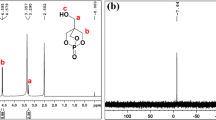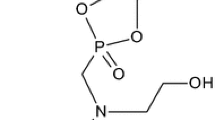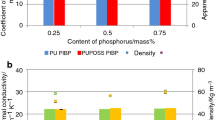Abstract
In this study, 2-carboxyethyl(phenyl)phosphinic acid (CEPPA) and trimethylolpropane (TMP) are used to synthesise a novel flame retardant containing phosphorus units: 5-hydroxy-3-(2-hydroxyethyl)-3-methylpentyl-3-[2-carboxyethylphenylphosphine]propanoate (HMCPP). Then, 4,4′-diphenylmethane diisocyanate (MDI) is taken as a hard segment, with HMCPP and polycaprolactone diol (PCL) as soft segments, and 1,4-butanediol (BD) is used as a chain extender to prepare a novel polyurethane (HMCPP/PUs). The results of 1H NMR and FT-IR reveal the successful synthesis of the HMCPP flame retardant. The gel permeation chromatography analysis demonstrates that an increase in the HMCPP content is accompanied by a decrease in the molecular weight of PU. The FT-IR analysis reveals the complete NCO group exhaustion of PU and HMCPP/PUs. The thermal analysis shows that the initial decomposition temperature of PU is higher than that of HMCPP/PUs by 19 °C. Both DMA and DSC analyses show that the Tg and the dynamic Tg of PU are higher than those of HMCPP/PU. Stress-strain tests indicate that the HMCPP content is increased, the maximum stress and Young’s modulus of HMCPP/PUs are decreased, and the elongation at break is increased. All of the HMCPP/PUs exhibit excellent flame retardancy, obtaining higher than 27.7 in limiting oxygen indices and a V-0 rating in the UL-94 test.











Similar content being viewed by others
References
Abraham GA, de Queiroz AAA, San Roman JS (2006) Hydrophilic hybrid IPNs of segmented polyurethanes and copolymers of vinylpyrrolidone for applications in medicine. Biomaterials 22:1971–1985
Tien YI, Wei KH (2001) Hydrogen bonding and mechanical properties in segmented montmorillonite/polyurethane nanocomposites of different hard segment ratios. Polymer 42:3213–3221
Mequanint K, Sanderson R (2003) Nano-structure phosphorus-containing polyurethane dispersions: synthesis and crosslinking with melamine formaldehyde resin. Polymer 44:2631–2639
Gugliuzza A, Clarizia G, Golemme G, Drioli E (2002) New breathable and waterproof coatings for textiles: effect of an aliphatic polyurethane on the formation of PEEK-WC porous membranes. Eur Polym J 38:235–242
Park HB, Lee YM (2002) Separation of toluene/nitrogen through segmented polyurethane and polyurethane urea membranes with different soft segments. J Membr Sci 197:283–296
Gunatillake P, Mayadunne R, Adhikari R, El-Gewely MR (2006) Recent developments in biodegradable synthetic polymers. Biotechnol Annu Rev 12:301–347
Mohanty AK, Misra M, Drzal LT (2002) Sustainable bio-composites from renewable resources: opportunities and challenges in the green materials world. J Polym Environ 10:19–26
Mohanty AK, Misra M, Hinrinchsen G (2000) Biofibres, biodegradable polymers and biocomposites: an overview. Macromol Mater Eng 276–277:1–24.
Chandra R, Rustgi R (1998) Biodegradable polymers. Prog Polym Sci 23:1273–1335
Okada M (2002) Chemical syntheses of biodegradable polymers. Prog Polym Sci 27:87–133
Nair LS, Laurencin CT (2007) Biodegradable polymers as biomaterials. Prog Polym Sci 32:762–798
Pena J, Corrales T, Izquierdo-Barba I, Doadrio AL, Vallet-Regi M (2006) Long term degradation of poly(ε-caprolactone) films in biologically related fluids. Polym Degrad Stab 91:1424–1432
Coulembier O, Degee P, Hedrick JL, Dubois P (2006) From controlled ring-opening polymerization to biodegradable aliphatic polyester: especially poly(b-malic acid) derivatives. Prog Polym Sci 31:723–747
Jiang X, Li JH, Ding MM, Tan H, Ling QY, Zhong YP (2007) Synthesis and degradation of nontoxic biodegradable waterborne polyurethanes elastomer with poly(ε-caprolactone) and poly(ethylene glycol) as soft segment. Eur Polym J 43:1838–1846
Tsou CH, Lee HT, Tsai HA, Cheng HJ, Suen MC (2013) Synthesis and properties of biodegradable polycaprolactone/polyurethanes by using 2,6-pyridinedimethanol as a chain extender. Polym Degrad Stab 98:643–650
Sain M, Park SH, Suhara F, Law S (2004) Flame retardant and mechanical properties of natural fibre–PP composites containing magnesium hydroxide. Polym Degrad Stab 83:363–367
Zhu S, Shi W (2003) Thermal degradation of a new flame retardant phosphate methacrylate polymer. Polym Degrad Stab 80:217–222
Liu YL, Hsiue CH, Lan CW, Kuo JK, Jeng RJ, Chiu YS (1997) Synthesis, thermal properties, and flame retardancy of phosphorus containing polyimides. J Appl Polym Sci 63:875–882
Yeh JT, Hsieh SH, Cheng YC, Yang MJ, Chen KN (1998) Combustion and smoke emission properties of poly(ethylene terephthalate) filled with phosphorous and metallic oxides. Polym Degrad Stab 61:399–407
Banks M, Ebdon JR, Johnson M (1994) The flame-retardant effect of diethylvinyl phosphonate in copolymers with styrene, methyl-methacrylate, acrylonitrile and acrylamide. Polymer 35:3470–3474
Cheng TC, Chiu YS, Chen HB, Ho SY (1995) Degradation of phosphorus-containing polyurethanes. Polym Degrad Stab 47:375–381
Liu YL, Hsiue GH, Lee RH, Chiu YS (1997) Phosphorus-containing epoxy for flame retardant. III: using phosphorylated diamines as curing agents. J Appl Polym Sci 63:895–901
Zhao H, Wang YZ, Wang DY, Wu B, Chen DQ, Wang XL, Yang KK (2003) Kinetics of thermal degradation of flame retardant copolyesters containing phosphorus linked pendent groups. Polym Degrad Stab 80:135–140
Chen-Yang YW, Yuan CY, Li CH, Yang HC (2003) Preparation and characterization of novel flame retardant (aliphatic -phosphate)cyclotriphosphazene-containing polyurethanes. J Appl Polym Sci 90:1357–1364
Liu YL, Hsiue GH, Lan CW, Chiu YS (1997) Flame-retardant polyurethanes from phosphorus-containing isocyanates. J Polym Sci A Polym Chem 35:1769–1780
Chang TC, Chiu YS, Chen HB, Ho SY (1995) Degradation of phosphorus-containing polyurethanes. Polym Degrad Stab 47:375–381
Chang TC, Shen WY, Chiu YS, Ho SY (1995) Thermo-oxidative degradation of phosphorus-containing polyurethane. Polym Degrad Stab 49:353–360
Çelebi F, Polat O, Aras L, Güngör G, Akhmedov Idris M (2004) Synthesis and characterization of water-dispersed flame-retardant polyurethane resin using phosphorus-containing chain extender. J Appl Polym Sci 91:1314–1321
Huang WK, Yeh JT, Chen KJ, Chen KK (2001) Flame retardation improvement of aqueous-based polyurethane with aziridinyl phosphazene curing system. J Appl Polym Sci 79:662–673
Arun Prasath R, Nanjundan S, Pakula T, Klapper M (2004) Thermal and dynamic mechanical behaviour of calcium containing co-polyurethanes. Polym Degrad Stab 85:911–923
Cullis CF, Hirschler MM (1984) Char formation from Polyolefins. Eur Polym J 20:53–60
Wang DY, Liu Y, Wang YZ, Artiles CP, Hull TR, Price D (2007) Fire retardancy of a reactively extruded intumescent flame retardant polyethylene system enhanced by metal chelates. Polym Degrad Stabil 92:1592–1598
Author information
Authors and Affiliations
Corresponding author
Rights and permissions
About this article
Cite this article
Chiu, SH., Wu, CL., Lee, HT. et al. Synthesis and characterisation of novel flame retardant polyurethanes containing designed phosphorus units. J Polym Res 23, 205 (2016). https://doi.org/10.1007/s10965-016-1098-y
Received:
Accepted:
Published:
DOI: https://doi.org/10.1007/s10965-016-1098-y




